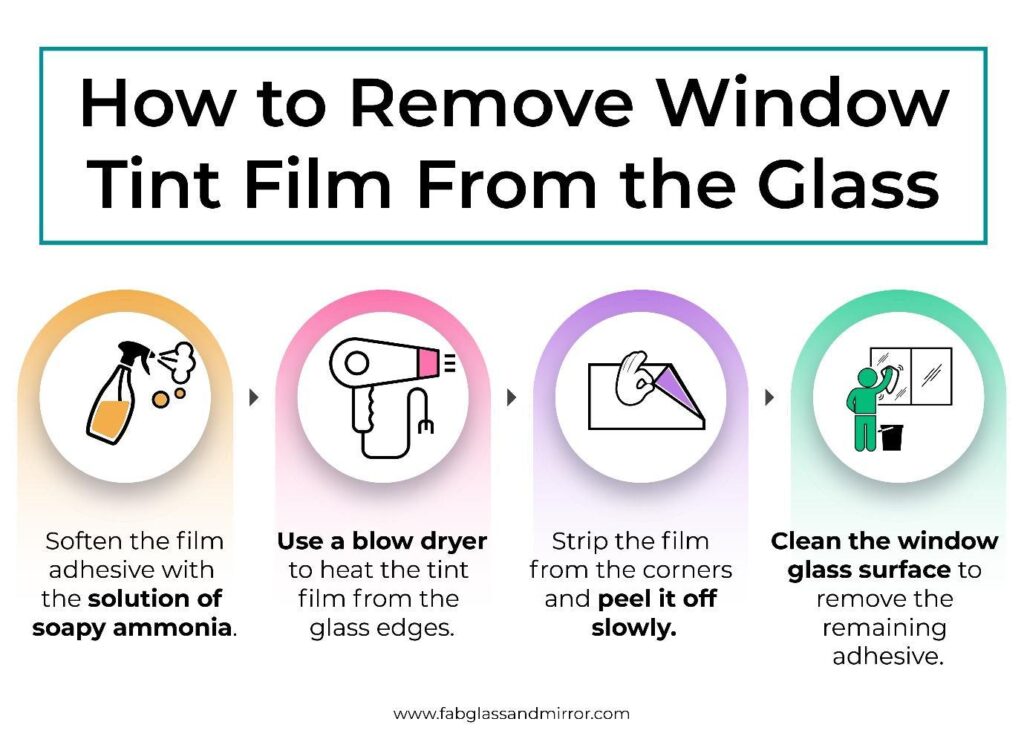How to Remove Window Tinting Film
by siteadmin

How to Remove Window Tinting Film
Yes, window tint can be removed, but it takes some time and a lot of patience. The main challenge is loosening the adhesive that holds it on.
Depending on the weather outside, you may not even need to use a heat source or ammonia first to release the glue. If you do, however, the process goes much faster.
Soak it in soapy water
If you’re tired of your car’s window tint or it has started to bubble, there are a few ways to remove it without damaging the glass. You can use heat, soapy water or even a hairdryer to loosen the adhesive and make it easier to peel away.
Before you start, be sure to protect your car interiors with tarps or plastic sheets and wear safety gloves and glasses. Also, a spray bottle of isopropyl alcohol and a scraper works well for removing remaining glue from the windows.
Using a razor blade, cut a corner of the tint film and peel it off slowly. To prevent tearing, soak the area with soapy water before you begin and rinse frequently. The more you soak the window, the more the glue will soften. If the tint film is still stuck, try spraying it with more soapy water.
Steam it
A steamer works better than a heat gun at loosening tint adhesive. This is a better option for those worried about damaging the glass or other parts of the vehicle.
A simple handheld steamer is fine for this job. Thoroughly soak the window with hot soapy water and cover with a piece of newspaper to keep it moist. Be sure to protect furniture and flooring near the window with tarps to avoid damage. Soak the film for an hour, adding more newspaper pieces as needed to keep it wet.
As the ammonia breaks down the tint, you’ll be able to peel it away easily. Afterward, spray the area with soapy water to remove any remaining glue residue. If there’s still some stuck to the glass, use 90 percent isopropyl alcohol to clear it. Then, wash the glass with a commercial glass cleaner to shine it up. A quality razor blade is also helpful for removing the tint’s edges.
Apply ammonia
It's best to avoid using cleaning products that are ammonia-based. These can lighten the tint film and make it less effective in blocking UV rays from the sun. The use of ammonia-based cleaners can also cause the film to become brittle, which can cause it to crack.
If you're unable to get a steamer at home, there is another way of loosening the adhesive without damaging your window glass. You can also try using a hair dryer or heat gun to loosen the glue, but these methods take longer and aren't as efficient as steaming.
For this method, you will need a spray bottle of soapy water, plastic sheets or garbage bags cut to the size of your window, and a can of ammonia. Spray the black plastic bags with the soapy water, then cover your windows with them. Leave this setup outside on a sunny day, so the heat from the sun can help the ammonia break down the adhesive and make the tint easier to peel.
Scrape it
Whether your window tint has become discolored, bubbly or otherwise degraded, you’re probably not going to want it on your windows anymore. Window tints can change color over time due to age, fading or improper installation, and this color change will diminish the tint’s ability to block UV rays.
A heat gun can be used to remove window tint film, although you might need to use a razor blade scraper to get the last bits of adhesive off the glass. This process is best done outside on a warm sunny day.
Using this method requires a few key ingredients, like a fabric steamer, a spray bottle of soapy water, tarp and a large garbage bag. Start the removal by rolling down the window a little and giving yourself an inch or two of access along the top edge. Then, start steaming the window and allow it to loosen up a bit before you move on to the next step.
How to Remove Window Tinting Film Yes, window tint can be removed, but it takes some time and a lot of patience. The main challenge is loosening the adhesive that holds it on. Depending on the weather outside, you may not even need to use a heat source or ammonia first to release the glue.…
Recent Posts
- Junk Removal Temecula: Your Trusted Partner for Clean and Clutter-Free Spaces
- Junk Removal Temecula: Your Trusted Partner for Clean and Clutter-Free Spaces
- Transforming Businesses with Expert Los Angeles SEO Services
- Thousand Oaks Remodeling Pros Revolutionizes Bathroom Remodeling in Thousand Oaks
- Butte Roofing Company: Premier Roofing Contractors Transforming Roofs in Butte, MT
